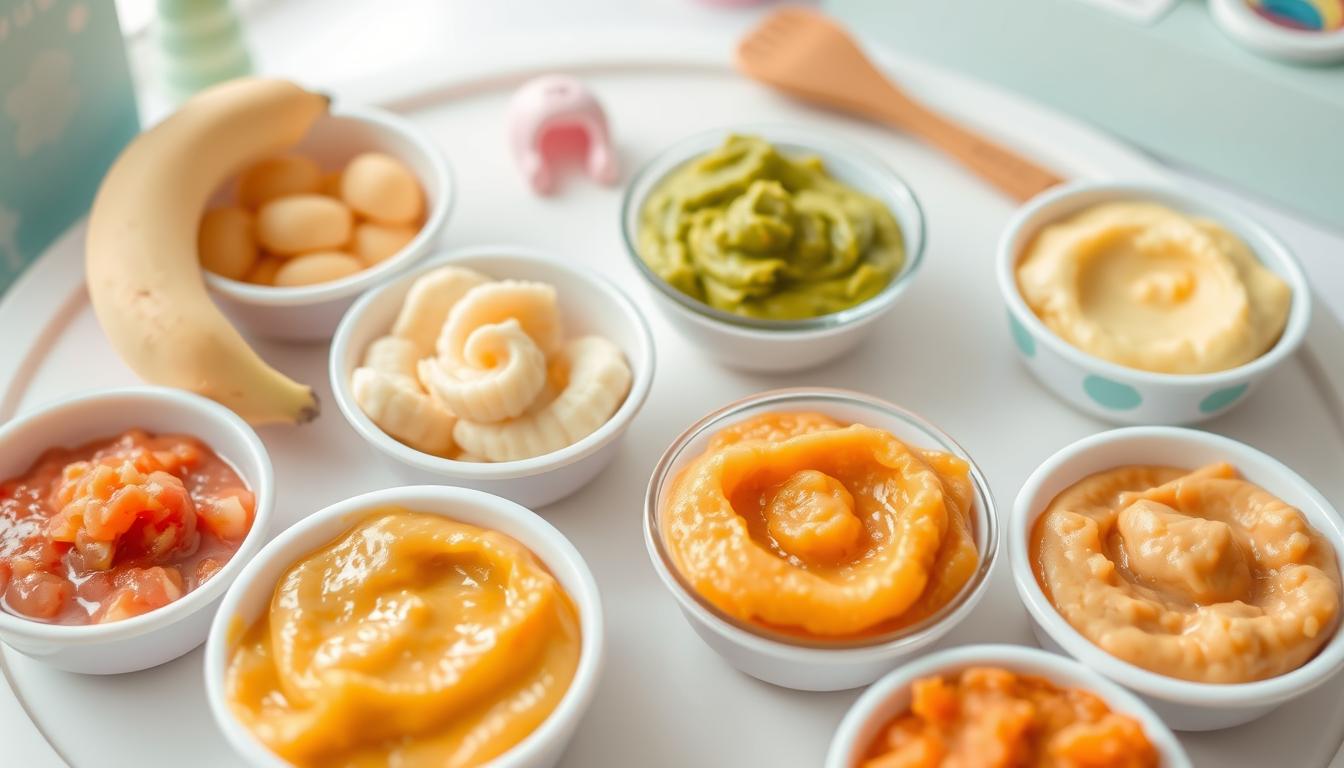When your baby hits 6 months, it’s time to start with solid foods. This marks the beginning of a new chapter in their diet. But, if your baby doesn’t have teeth yet, you might wonder what’s safe and good for them. This guide will help you find the best foods for your 6-month-old baby without teeth. It’s all about starting them off right with a variety of tasty and healthy options.
Foods for 6 Month Old baby with no teeth
Key Takeaways
- Discover safe and nutritious first foods for 6-month-olds with no teeth
- Learn how to properly prepare and serve soft, easily-digestible foods
- Understand the importance of textures and consistency when introducing solids
- Explore a variety of fruit and vegetable options ideal for baby-led weaning
- Gain insights on incorporating protein-rich foods into your baby’s diet
Understanding Your Baby’s Nutritional Needs at 6 Months
When your baby hits 6 months, their diet needs change. It’s a thrilling time to start with nutritious baby meals and baby-led weaning. Knowing what nutrients are important for growth is key.
Key Nutrients for Healthy Development
At 6 months, your baby needs a mix of important vitamins and minerals. These include:
- Iron: Helps make red blood cells and supports brain growth.
- Zinc: Important for the immune system, healing, and taste.
- Vitamin A: Good for eyes, skin, and the immune system.
- Vitamin C: Helps the body absorb iron and boosts the immune system.
- Calcium: Essential for strong bones and teeth.
Signs Your Baby is Ready for Solids
Spotting the right time to start solids is important. Look for these signs:
- Sitting up and controlling their head.
- Showing interest in your food.
- Reaching for or opening their mouth when offered food.
- Being able to swallow food without pushing it out.
Recommended Daily Intake Guidelines
Get advice from a paediatrician or nutritionist on your baby’s daily needs. They can tailor advice based on your baby’s growth and health.
“Introducing solid foods at the right time and in the right way can help ensure your baby gets all the essential nutrients they need for healthy growth and development.”
Soft and Safe First Foods to Introduce
Introducing solid foods to a 6-month-old baby is all about soft, mushy textures. These “finger foods” for infants should be easy to gum and swallow. They must also be free of choking hazards and packed with nutrients for growth.
Here are some soft and safe first foods for your little one:
- Ripe, soft-cooked fruits like banana, avocado, peach, and pear
- Soft-cooked vegetables like sweet potato, carrot, pumpkin, and zucchini
- Smooth, single-grain infant cereals made from rice, oats, or barley
- Soft-cooked pasta or rice, broken into small pieces
- Unsweetened yogurt or cottage cheese
When preparing these soft foods, mash, puree, or finely chop them. This makes them easy for your baby to manage without teeth. Stay away from harder, chunkier textures that could be a choking hazard.
| Food | Preparation Tips | Nutrients Provided |
|---|---|---|
| Banana | Mash or blend into a smooth puree | Potassium, vitamin B6, fiber |
| Sweet Potato | Steam until very soft, then mash or puree | Vitamin A, vitamin C, fiber |
| Infant Cereal | Mix with breastmilk or formula to a smooth, runny consistency | Iron, zinc, B vitamins |
Every baby is unique, so be patient and watch closely as you introduce new soft foods. If your little one likes a particular food, you can gradually increase the amount. This helps them get used to more textured finger foods as they grow.
Best Fruits and Vegetables for Baby-Led Weaning
Starting your baby on baby-led weaning? Fruits and veggies are great to begin with! Choose soft, easy-to-hold options for your 6-month-old. Let’s look at the best choices to help your baby grow and enjoy new tastes.
Preparing Soft Fruits for Baby
Soft fruits like bananas, avocados, and peaches are perfect for beginners. Just mash or cut them into big, soft bits for your baby to try. Stay away from citrus fruits, as they’re too acidic.
Cooking Vegetables to Perfect Softness
Steaming or roasting veggies makes them soft and tender. This is great for your baby to chew and swallow. Sweet potato, carrot, zucchini, and butternut squash are excellent choices. Cut them into big, easy-to-handle pieces.
Storage Tips for Fresh Produce
- Keep fruits and veggies in the fridge to keep them fresh and full of nutrients.
- Freeze extra cooked veggies in portions for quick, healthy meals.
- Always wash produce before serving to get rid of dirt and bacteria.
Offering a variety of soft fruits and veggies helps your baby develop good eating habits. Enjoy exploring new tastes, little one!
Foods for 6 Month Old Baby with No Teeth: Complete Guide
When your baby hits 6 months, it’s time to start with solid foods. But, since they don’t have teeth yet, pick soft, easy-to-swallow foods full of nutrients. This guide will show you tasty options to feed your baby during this important time.
Smooth and Creamy Baby Purees
Purees are perfect for babies without teeth. Make homemade purees with foods like:
- Sweet potatoes
- Avocado
- Butternut squash
- Pumpkin
- Peas
- Bananas
Blend these into a smooth, creamy mix. It’s easy for your baby to gum and swallow. Try mixing different flavors for a variety of tastes.
Soft and Tender Finger Foods
When your baby gets better at moving, try soft finger foods. Good choices are:
- Steamed and mashed sweet potato or carrot sticks
- Ripe, soft-cooked pear or apple slices
- Soft-cooked chicken or salmon pieces
- Mashed avocado or hummus
Always watch your baby while they eat. Cut foods into small pieces to avoid choking.
TO WATCH VIDEO CLICK HERE
Offering a variety of soft foods for infants helps your baby grow strong and healthy. It also helps them learn to feed themselves and try new tastes.
Making Nutritious Homemade Baby Purees
Making homemade baby purees is rewarding and saves money. It lets you control what goes into your baby’s food. This way, you avoid harmful additives and preservatives.
Essential Kitchen Tools for Pureeing
You’ll need a few tools to make smooth baby purees. A good food processor or blender is key. Also, a strong saucepan or steamer and soft utensils are important.
Step-by-Step Pureeing Guide
- Start by picking fruits, veggies, or grains and wash them well.
- Steam or boil them until they’re soft. Let them cool a bit.
- Put the cooked ingredients in a food processor or blender. Blend until smooth.
- If it’s too thick, add a bit of breastmilk, formula, or water.
- Check the taste and add salt or lemon juice if needed.
Batch Cooking and Storage Methods
Batch cooking saves time and keeps your baby’s food fresh. Cook big batches of purees. Then, freeze them in airtight containers or ice cube trays. This makes it easy to serve fresh, homemade meals.
| Fruit/Vegetable | Recommended Cooking Time | Ideal Texture |
|---|---|---|
| Sweet Potatoes | 12-15 minutes | Smooth and creamy |
| Carrots | 10-12 minutes | Soft and velvety |
| Peas | 5-7 minutes | Delicate and smooth |
Try different ingredients to find what your baby likes. With practice, making healthy baby food at home will become easy.
Safe Food Textures and Consistency Guidelines
Introducing solid foods to your little one without teeth is a delicate task. It’s important to make sure the foods you offer are safe and right for their age. By following these guidelines, you can help prevent choking and encourage healthy eating habits for your 6 month old baby with no teeth.
Start with very soft, smooth purees and then move to slightly thicker, more textured foods as your baby gets better at eating them. Stay away from hard, crunchy or stringy foods that could be a choking hazard. Here are some tips to keep in mind:
- Puree consistency: Aim for a smooth, creamy texture without any lumps or chunks.
- Mashed foods: Mash fruits and vegetables to a soft, spreadable consistency, ensuring there are no hard pieces.
- Finger foods: Cut soft, cooked foods into small, bite-sized pieces that can be easily gummed or sucked on.
“Patience and a gentle approach are essential when introducing new textures to your baby. Pay close attention to their cues and never force them to eat more than they’re comfortable with.”
As your baby gets better at chewing and swallowing, you can make their meals thicker and lumpier. But always be careful, and talk to your paediatrician if you’re unsure about the right food textures for your 6 month old baby with no teeth.
Introducing Protein-Rich Foods Safely
When your 6-month-old baby starts eating solids, introducing protein is key. It’s vital for their growth. We’ll look at safe, plant-based and animal-based options for this stage.
Plant-Based Protein Options
Legumes like mashed chickpeas, lentils, and pureed beans are great for plant-based protein. They’re easy to mash or blend, making them perfect for babies. Tofu and tempeh are also good, offering a soft texture for little mouths.
Animal Protein Preparations
Start with smooth, pureed meats like chicken, turkey, or fish for animal proteins. Avoid tough cuts or diced pieces to prevent choking. Soft-cooked eggs, as a whole-egg puree or mashed hard-boiled yolk, are also safe.
Combining Proteins with Other Foods
- Mix mashed lentils or chickpeas with pureed veggies for a balanced meal.
- Combine pureed chicken or fish with avocado or olive oil for extra calories and nutrients.
- Add smooth nut or seed butter to fruit or veggie purees for a protein boost.
Introduce new foods one at a time and watch for any allergic reactions. Offering a variety of protein-rich foods helps your baby develop a healthy diet.
Common Food Allergies and How to Avoid Them
When introducing solids to your 6-month-old baby with no teeth, watch out for food allergies. Some foods can cause allergic reactions in babies. Knowing which foods are common allergens helps you wean your baby safely.
The main food allergens for babies are cow’s milk, eggs, peanuts, tree nuts, soy, and wheat. To avoid allergic reactions, introduce these foods one at a time. Start with small amounts and watch for any signs of an allergic response.
- Look out for symptoms like rash, hives, swelling, vomiting, or diarrhoea after trying a new food.
- If an allergic reaction happens, stop that food and talk to your child’s doctor.
- Later, you can try the food again, but only if your paediatrician says it’s okay.
By being careful and cautious, you can make sure your 6-month-old baby with no teeth has a safe start with solid foods.
| Common Allergens | Symptoms to Watch For | Recommended Approach |
|---|---|---|
| Cow’s milk, eggs, peanuts, tree nuts, soy, wheat | Rash, hives, swelling, vomiting, diarrhoea | Introduce one food at a time, in small amounts, with close monitoring |
Every baby is different. It’s crucial to work with your child’s healthcare provider for a safe and healthy weaning journey.
Conclusion
As your baby hits the 6-month mark without teeth, this guide has covered everything you need to know. It’s all about understanding their nutritional needs and finding the right first foods. You’re now ready to start this exciting new chapter in your child’s eating journey.
Every baby is different, so it’s crucial to watch for their cues and get advice from your pediatrician. By offering a variety of healthy foods, you’re helping your baby develop good eating habits. This will support their growth and development.
Start this adventure with confidence, trust your instincts, and cherish the moments. Introducing solid foods to your baby is a special time. With patience and creativity, you’ll make this transition smooth and enjoyable for both of you.
FAQ
What are the best foods for a 6-month-old baby with no teeth?
For a 6-month-old baby with no teeth, soft foods are best. Try mashed fruits like bananas and avocados. Also, pureed pears are great.
Soft, cooked veggies like sweet potatoes and carrots are good too. Don’t forget iron-fortified baby cereal. Make sure the foods are smooth and easy to swallow.
How can I safely introduce finger foods to my 6-month-old with no teeth?
Start with soft, ripe fruits and veggies for finger foods. Steamed broccoli and soft apple or pear slices are good.
Avocado strips are also a great option. Always watch your baby and make sure the food is small to avoid choking.
What are some nutritious homemade baby food recipes for a 6-month-old?
Homemade baby food can be nutritious and tasty. Try sweet potato puree or veggie blends like peas and carrots.
Fruit purees like banana-avocado or apple-pear are also good. Use fresh ingredients and store food safely to keep nutrients in.
How can I safely introduce protein-rich foods to my 6-month-old with no teeth?
Start with small amounts of pureed chicken or mashed beans. Yogurt is also a good option.
Make sure the food is smooth and well-cooked. Watch for signs of allergy when trying new proteins.
What are the signs my 6-month-old is ready to start solids?
Look for signs like sitting up and holding their head steady. If they show interest in your food, they might be ready.
They should also be able to move food from the front to the back of their tongue. Talk to your paediatrician to know when to start solids.
TO SEE MORE TOPICS CLICK HERE



